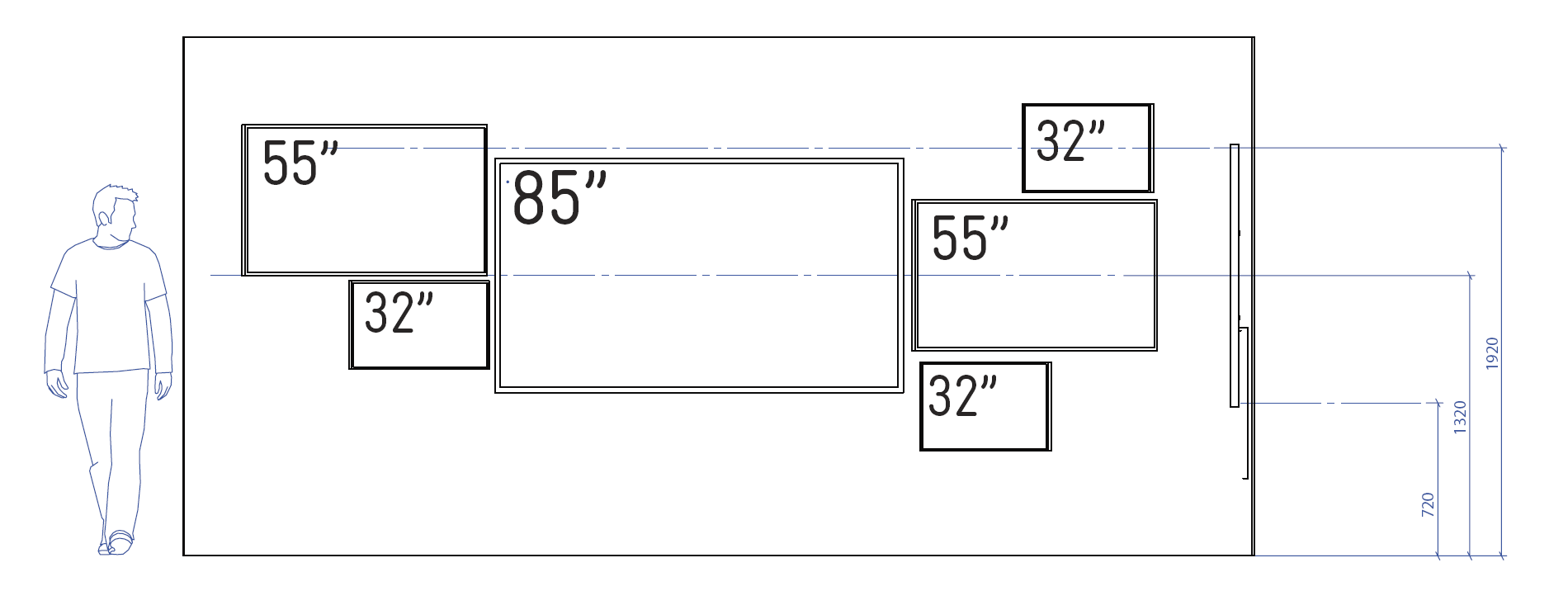“The Murals of Our Times”
The means for creating inspiring ambient, social and interactive cultural connections through digital screen installations has truly come of age.
The digital mural is a narrative device which can demonstrate a flowing landscape of ideas, events and artifacts of time and place, connecting individuals to a richer experience.
In this way they can add tremendous value to how people connect with the physical spaces they move through and spend time in.
Still from the permanent digital mural on the north wall of the Welcome Centre at Sydney Opera House. Creative: Sam Doust.
I've long had an interest in display technology, and specifically creating content for it. Over the past three years I've had the opportunity to explore the medium creatively, and witness the technical side of things flourish. Here at the end of 2019, the medium is in an exceptional place, whether you're interested in exploring passive or interactive narratives and experiences.
From Wallpaper magazine article: "creative director Sam Doust’s kaleidoscopic explorations of the House’s stories emanate for a mesmerising LED wall amid churning robotic surround sound." Photo: Felix Forest.
Recently I finished a digital mural exploring themes of place, architecture, performance and renewal for the Welcome Centre of the Sydney Opera House. This silent narrative spans 12 concurrent vertical 55" screens, creating an ultra-wide canvas of 19,027 x 1920 pixels.
Still from the permanent digital mural on the north wall of the Welcome Centre at Sydney Opera House. Creative: Sam Doust.
In this nine minute video sequence visitors and passers-by can dip in to an evocative survey of the history of Bennelong Point, the construction of Sydney Opera House, its legacy of performance and the decade of renewal currently being undertaken.
Still from the permanent digital mural on the north wall of the Welcome Centre at Sydney Opera House. Creative: Sam Doust.
Murals in Motion
Digital murals are illuminated canvases in motion, allowing for a fluid and evocative communication of many themes, including history of place and its cultural heritage, and the resurfacing of a storied past through artful interpretation in the present.
Through this recurrence, they work passively but effectively to reduce our everyday existence bias - that pervasive mind-set that holds us firmly within the present tense.
A foyer can be charged with anticipation before a performance, a library or museum can display its collections in motion, evoking a rich and creative history.
Permanent multi-screen installation on the south wall of the Welcome Centre at the Sydney Opera House. Photography installation by FRD Design. Digital screen content by Latchkey.
Communication in the digital mural space includes structured narratives, as well as artistic and interpretive installations.
Road to Zero is a free road safety education gallery within Melbourne Museum, developed in conjunction with the Transport Accident Commission. It educates visitors on how to prevent accidents and protect drivers, passengers, pedestrians, motorbike riders and cyclists. As an introduction to the larger exhibit, I was commissioned to create a multi-screen narrative aimed at engaging the general public, in particular teenagers, about the importance of road safety.
Each screen was used to explore different perspectives that begin disparately and converge, communicating how everything we do is connected and has consequence. Watch the narrative below (4:40).
In late 2016, I produced two 18 minute films for The Lounge, at Sydney Opera House. The large array Samsung screen, as seen below, was comprised of multiple units creating a wall-sized mural. It had a density of a diode for every pixel of a 1920 x 1080 resolution: over 2 million diodes and pixels per frame of animation.
Stills from the digital mural in The Lounge, Sydney Opera House.
An Evolving Technology
Over the past three years, large array and modular digital mural technology has definitely come of age, thanks to a combination of state of the art screen resolutions and the IP networks and codecs that serve them.
The technology of the screen has evolved from standard LCD and LED to OLED and MicroLED, all of which can be used in modular components to create very large arrays, or small integrated installations. They can be passive or interactive (activated through IR touch technology, or gesture, for example). Below are examples of these new technologies from Sony and Samsung.
Illuminated signage and electric billboards are nothing new, of course. Neon endures as a wonderful and highly skilled art form, while advertising and messaging are ever present in malls, airports and other high traffic spaces.
Looking north along The Strip, Las Vegas, Nevada, USA. Photo: Sam Doust.
Akihabara (秋葉原), Tokyo. Photo: Sam Doust.
Akihabara (秋葉原), Tokyo. Photo: Sam Doust.
But in terms of transmitting cultural narratives, digital murals are a medium with enormous potential for adding value to the experience of an internal or external space.
In the late 1940s, the Swiss-French architect, designer and urban planner Le Corbusier declared tapestry to be "the murals of our times".
More than half a century on, we might attribute the same sentiment to the design potential of digital screens and their ability to enrich the spaces we inhabit.
Still from the permanent digital mural on the north wall of the Welcome Centre at Sydney Opera House. Creative: Sam Doust.











